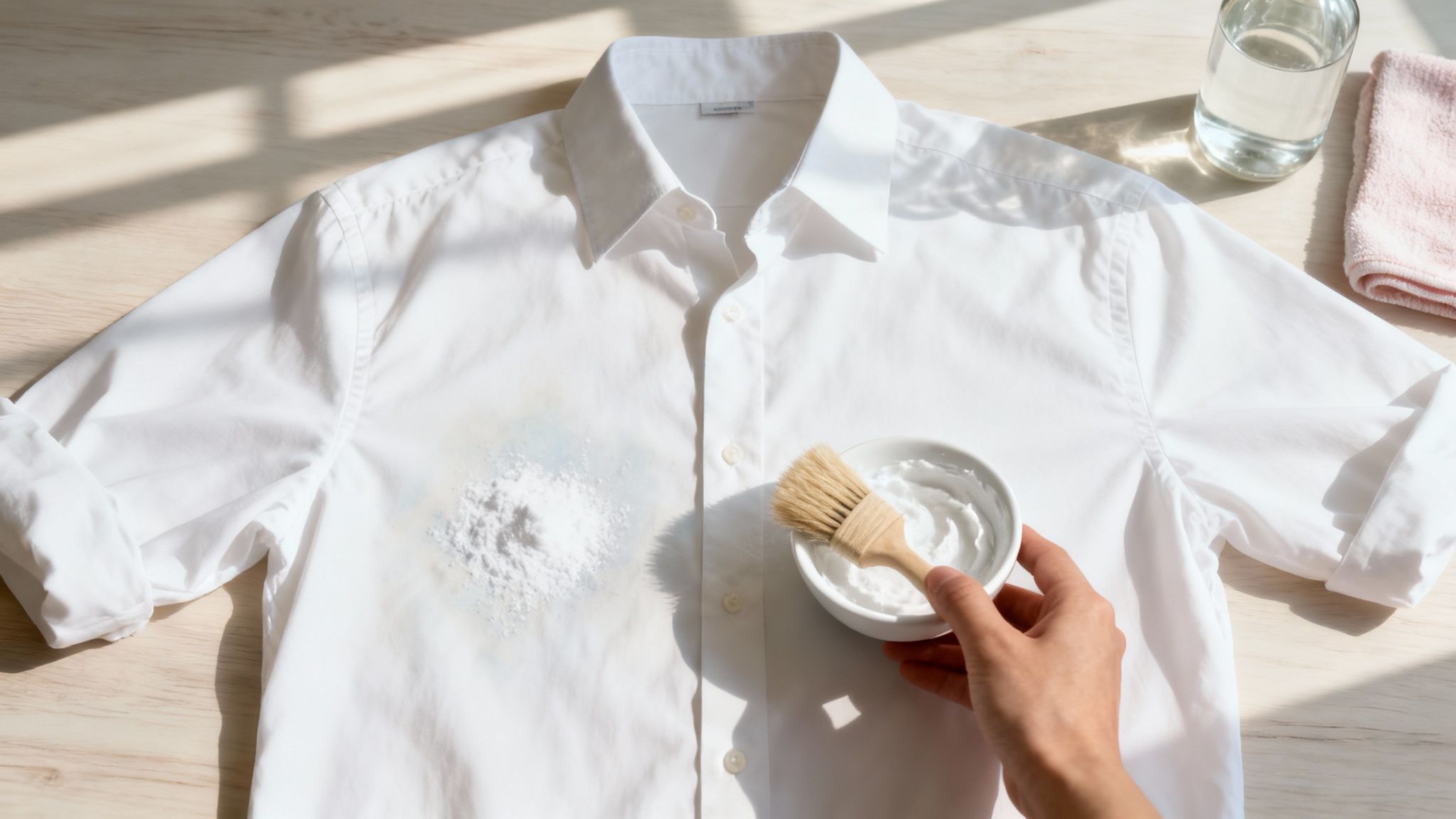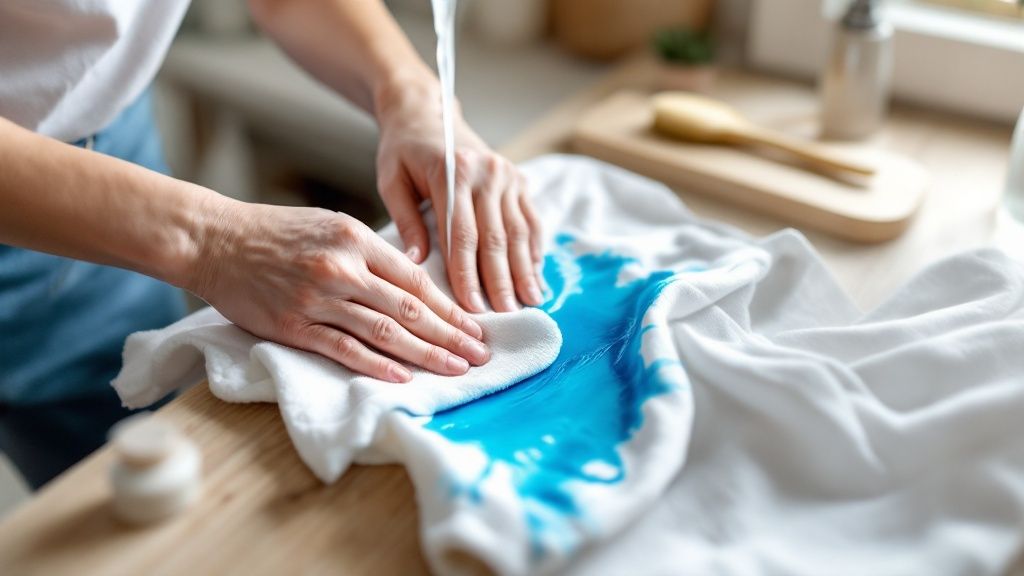How to Remove Ink from Clothes Like an Expert
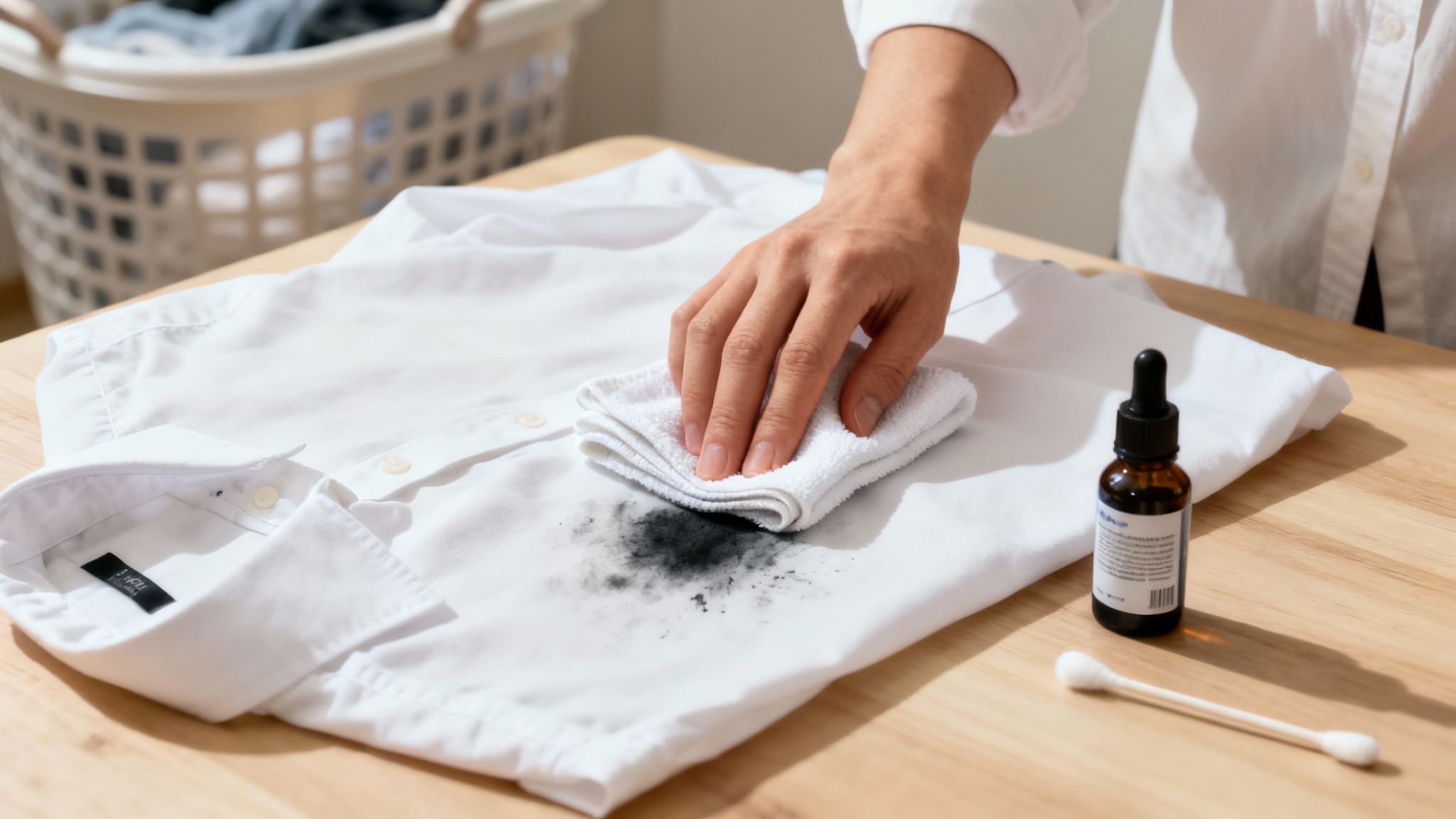
That sudden ink splotch on your favorite shirt feels like a catastrophe, but it doesn't have to be a permanent one. I've seen it all, and trust me, most ink stains are surprisingly manageable if you act fast and use the right approach.
The absolute golden rule? Blot, don't rub. From there, it's all about treating the stain with a solvent—often something as simple as rubbing alcohol—before it has a chance to permanently set.
Your Quick Guide to Winning the Ink Stain Battle
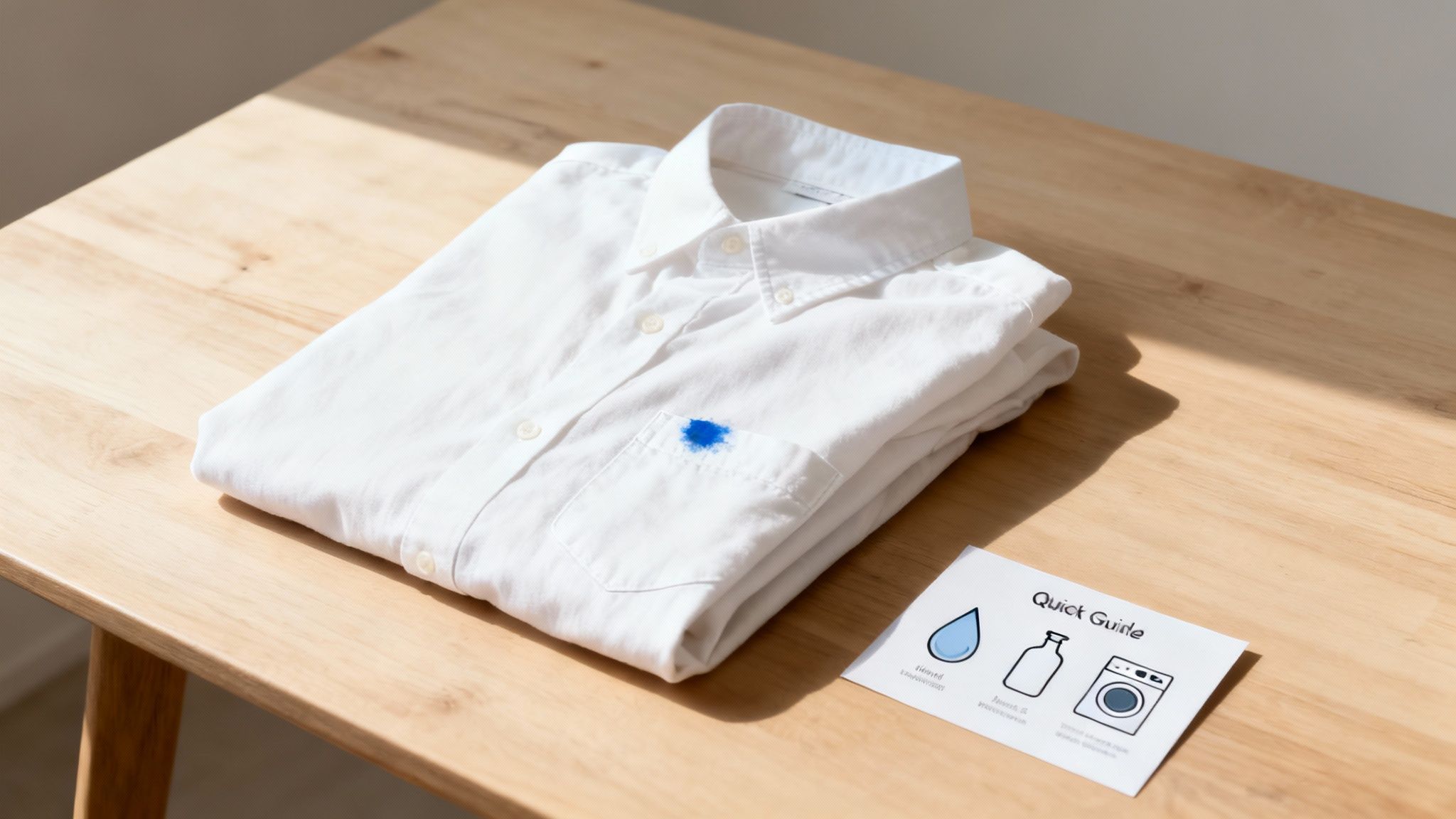
An unexpected ink mark can send anyone into a panic, but the solution is often already sitting in your medicine cabinet or kitchen. This guide cuts through the noise to give you practical, tested strategies for every type of ink and fabric.
We’ll dig into why certain household items work wonders and, just as importantly, how to tackle different materials without causing more damage. Think of this as your go-to playbook for turning an ink emergency into a simple laundry win.
Why Acting Fast is Your Best Defense
When it comes to successfully removing an ink stain, speed is everything. It's the single most important factor.
Fresh ink is just sitting on the surface of the fabric's fibers, which makes it much easier to lift out. Once it dries and sets, the pigment actually bonds with the fibers. That's when you're facing a much tougher, more stubborn challenge.
- Fresh Stains: Immediately blotting a new stain with a clean, dry cloth can absorb up to 50% of the ink before you even apply a remover. This one simple action keeps the ink from spreading and seeping deeper into the fabric.
- Set-in Stains: Older, dried stains require more patience and usually stronger solvents. This not only takes more work but also increases the risk of damaging the garment itself. The goal is always to treat it while it’s fresh.
Here’s a piece of advice I always give: Never, ever apply heat to an ink stain you’re not 100% sure is completely gone. A trip through a hot dryer will permanently set any remaining ink, making it nearly impossible to remove later.
Old-School Wisdom Meets Modern Chemistry
The battle against ink stains is nothing new. Long before modern detergents, people relied on some pretty clever household remedies. For instance, 19th-century household manuals often recommended soaking fresh ink stains in milk. For dried spots, a paste of salt and lemon juice was a popular go-to.
These early methods used natural acids and solvents to break down the ink, proving that the core principles of stain removal have some seriously deep roots. It’s fascinating stuff.
For parents who feel like they're constantly dealing with all sorts of spills and marks, this ultimate guide to removing stains from children's clothes is an excellent, much broader resource.
To help you get started right away, I've put together a quick reference table. It's designed to give you an at-a-glance solution so you can make the best first move for your specific stain.
Quick Ink Stain Treatment Guide
This table should get you pointed in the right direction. Just remember to always test your chosen remover on an inconspicuous area of the garment first to ensure it doesn't cause any discoloration or damage.
Identify Your Ink Stain and Fabric Type
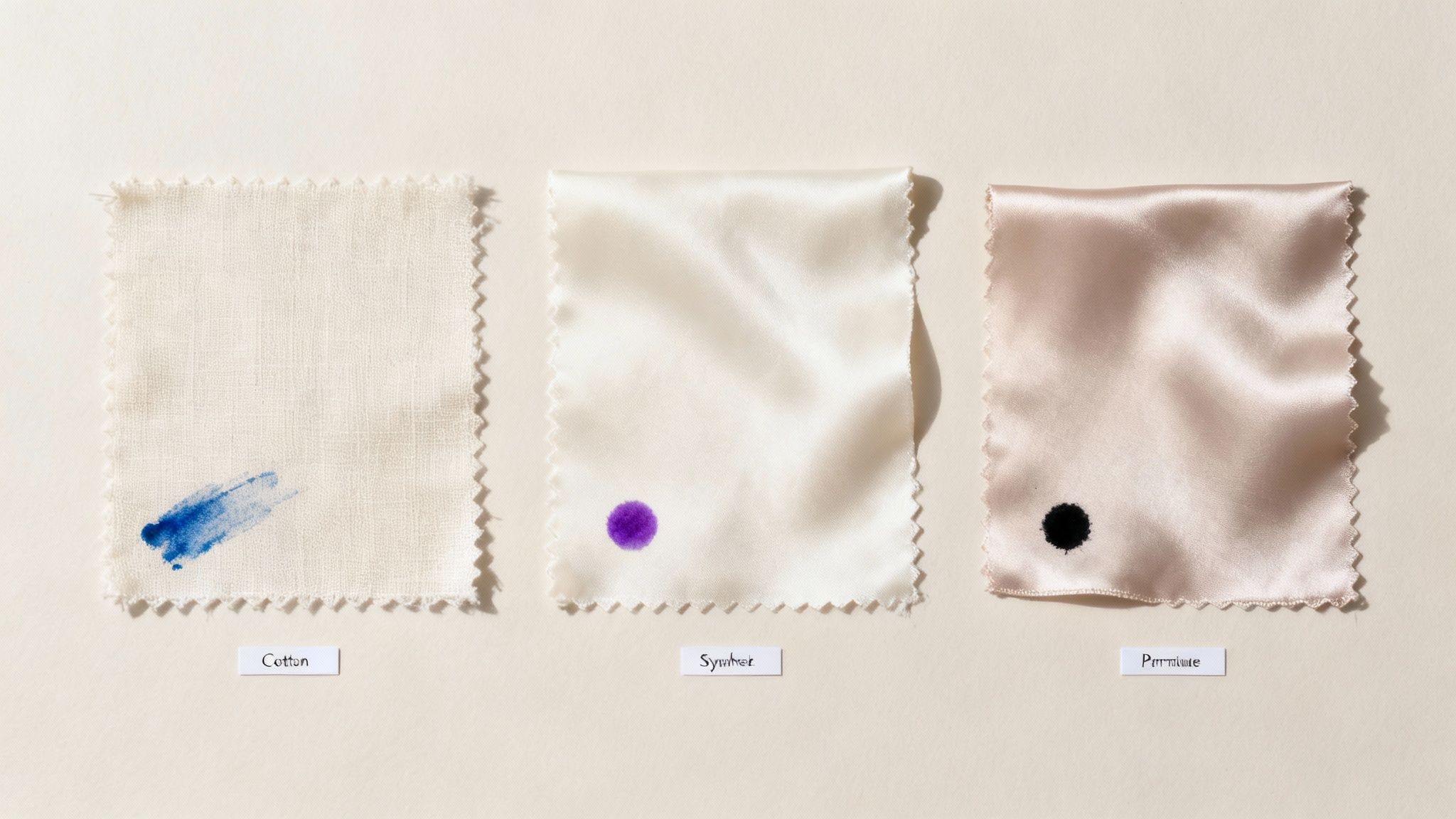
Before you frantically start scrubbing that ink stain, take a breath. Successful ink removal begins with a quick diagnosis, not brute force. The strategy for a leaky ballpoint pen is completely different from a permanent marker mishap, and using the wrong solution can set the stain for good or even ruin the fabric.
So, let's play detective for a minute.
First, you need to know what kind of ink you're dealing with. Most clothing stains come from one of three culprits, and each one needs a unique approach.
- Water-Based Inks: Think rollerball pens, gel pens, and those washable markers your kids love. As the name suggests, their base is water, which makes them the easiest to remove. Often, a little soap and water is all it takes.
- Oil-Based Inks: This is your classic ballpoint pen ink. The oily base repels water, which explains why just tossing it in the wash does absolutely nothing. For these, rubbing alcohol becomes your best friend, acting as a solvent to break down and lift the oil.
- Solvent-Based Inks: We're talking permanent markers here—the toughest of the bunch. They contain aggressive chemicals designed to make the ink last forever, so you'll need a much more potent approach to break those chemical bonds.
Know Your Fabric
Just as important as the ink is the fabric it’s on. A method that works wonders on a rugged cotton tee could completely destroy a delicate silk blouse. Taking a moment for understanding different fabric properties can save you a world of heartache.
Always start by checking the care tag inside the garment. That little tag is your roadmap. If it's missing, you'll have to use your best judgment.
- Sturdy Fabrics: Materials like cotton, denim, and most polyester blends are pretty tough. They can usually handle solvents like rubbing alcohol or even an alcohol-based hairspray without any issues.
- Delicate Fabrics: Things like wool, rayon, and silk demand a much gentler touch. Harsh solvents can easily cause discoloration, weaken the fibers, or leave a permanent mark. For these, professional care is almost always the safest bet. When you're dealing with a precious silk item, getting expert help with dry cleaning delicate silk can be the difference between saving it and saying goodbye.
Key Takeaway: Always, always do a spot test. Before you go all-in, apply a tiny amount of your cleaning solution to a hidden area, like an inside seam. Wait a few minutes, then blot it with a clean white cloth to see if any color transfers or if the fabric looks damaged. This simple step can prevent a minor cleanup from turning into a major disaster.
Tacking Ink Stains With Everyday Household Items
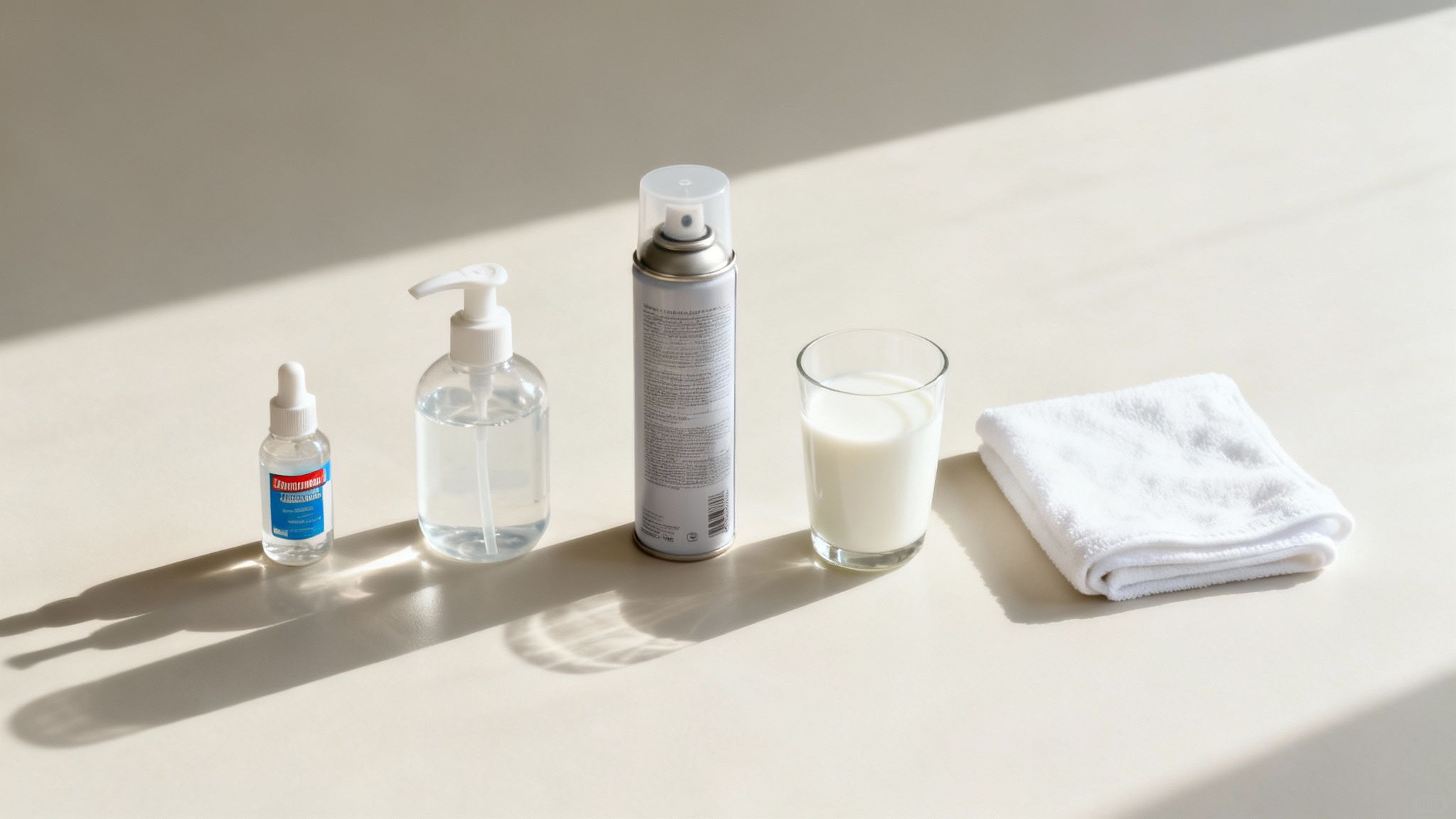
Before you rush out to buy a specialty cleaner, take a peek inside your kitchen and bathroom cabinets. You probably already have some of the best tools for fighting ink stains, especially those stubborn marks from a classic ballpoint pen. The secret isn't just what you use, but how you use it.
A classic mistake is to just drench the stain and scrub away, but that almost always backfires by spreading the ink around. The right approach is more about patience and precision. A small amount of the right product can work wonders, lifting the pigment right out of the fabric fibers.
The Power of Alcohol-Based Solutions
When you're faced with a fresh ink stain, your first thought should be alcohol. For oil-based inks—the kind found in most ballpoint pens—an alcohol-based solvent is your absolute best friend. It gets to work immediately, breaking down the oily parts of the ink so they can be lifted away from the fabric.
You’ve got a few great options that are likely already in your home:
- Rubbing Alcohol (Isopropyl Alcohol): This is the go-to choice. It’s a pure solvent that dissolves ink directly and effectively.
- Alcohol-Based Hairspray: In a pinch, hairspray can do the trick because its main ingredient is often alcohol. It’s a classic laundry hack for a reason, but double-check the label—the alcohol-free versions won’t help you here.
- Hand Sanitizer: Just like hairspray, most hand sanitizers have a high alcohol content, making them a fantastic on-the-go solution for small ink marks.
To use any of these, start by slipping a clean cloth or a few paper towels under the stain. This is a crucial step to stop the ink from bleeding through to the other side of your garment. Next, dampen a separate clean cloth with your alcohol solution and gently blot the stain. Always work from the outside edge inward to contain the mess. You’ll see the ink begin to transfer from your clothing to the cloth.
Always remember to blot, never rub. Rubbing just grinds the ink deeper into the fabric's weave. It can turn a small, manageable spot into a much larger, fainter mess that’s even harder to get out.
Gentle Options for Delicate Fabrics
But what if you're dealing with a more delicate material, like wool or certain synthetics, that might not handle a harsh alcohol treatment? You'll need a gentler approach. This is where a surprising kitchen staple comes into play: milk.
A milk soak can be remarkably effective, especially on fresh ink. The mild acids and fats in milk help gently lift and dissolve ink pigments without damaging sensitive fibers. Just submerge the stained part of the garment in a small bowl of milk and let it soak for at least an hour. Afterward, rinse it out and launder as you normally would.
Understanding the science behind stain removal is a game-changer. Studies show that when applied quickly, alcohol-based solvents have a success rate exceeding 70% on ballpoint ink. These solvents are designed to dissolve the specific dyes and oils in the ink, which is a key concept we explore in our guide on how stain removers work for every stain type. This one-two punch of immediate blotting followed by a solvent is a cornerstone of great fabric care. You can find even more insights from conservation research on stain removal experiments.
Time to Bring in the Big Guns: Advanced Tactics for Tough Stains and Delicates
Sometimes, that trusty bottle of rubbing alcohol just isn’t going to cut it. When you’re up against a stubborn, set-in stain or dealing with a delicate fabric like silk or wool, you need to call in the specialists. This is where we move beyond simple blotting and get into more strategic stain removal.
Think of it this way: your everyday household remedies are like general practitioners, but for serious issues, you need an expert. Commercial stain removers are those experts, and they usually fall into one of two camps. Knowing the difference is crucial for grabbing the right one when the stakes are high.
Choosing Your Commercial Stain Remover
Let’s be clear: not all store-bought stain removers are created equal. The right choice depends entirely on the type of ink and the fabric you're working with.
- Enzyme-Based Cleaners: These are fantastic for organic stains—think grass, blood, or that spaghetti sauce from last night. The enzymes work by breaking down proteins, but they often struggle with the synthetic dyes and solvents found in many inks.
- Solvent-Based Cleaners: For ink, especially the permanent kind, a solvent-based product is usually your best bet. These contain more aggressive chemicals designed to dissolve the tough, oil-based compounds that water and simple alcohols can't touch.
Before you even think about applying a commercial product, remember the golden rule: patch test first. Find a hidden spot, like an inside seam or hem, and apply a small amount. You need to be sure it won’t cause color loss or damage the fabric’s texture before you go all-in on the stain.
Handling Ink on Delicate Fabrics
When ink finds its way onto silk, wool, or leather, the situation gets pretty tricky. These materials are incredibly sensitive and can be easily ruined by harsh chemicals. A gentle, patient approach is non-negotiable here.
For a fabric like silk, a simple paste made from cornstarch and a little water can work wonders. Just apply the paste to the stain, let it dry completely, and then gently brush it away. The cornstarch is great at absorbing and lifting the ink from the delicate fibers without any aggressive rubbing. On wool, a highly diluted mix of white vinegar and water can be effective, but always blot gently with a clean, white cloth.
The challenge of removing ink from delicate textiles is a serious one, even for professional textile conservators. As highlighted in research, strong chemicals might remove the ink but can also cause irreversible damage to the fabric's delicate fibers. If you want to dive deeper into this delicate balance, you can explore the findings of this study on textile conservation.
The Ultimate Challenge: Permanent Marker
A permanent marker stain can feel like a total lost cause, but don't give up hope just yet. With the right approach, even these can sometimes be conquered. This is a situation where stronger solvents are necessary, but you have to be extremely cautious.
Start with a high-concentration rubbing alcohol—we’re talking 90% or higher. If that doesn’t make a dent, you might consider a dry-cleaning solvent, which can be purchased for home use. No matter what you choose, work in a well-ventilated area and use a light touch.
Honestly, some of these stains are notoriously difficult. Knowing when to wave the white flag and call for professional help is crucial. For more on tackling the toughest spots, check out our guide on treating the 5 most difficult stains.
The Final Wash and Post-Treatment Care
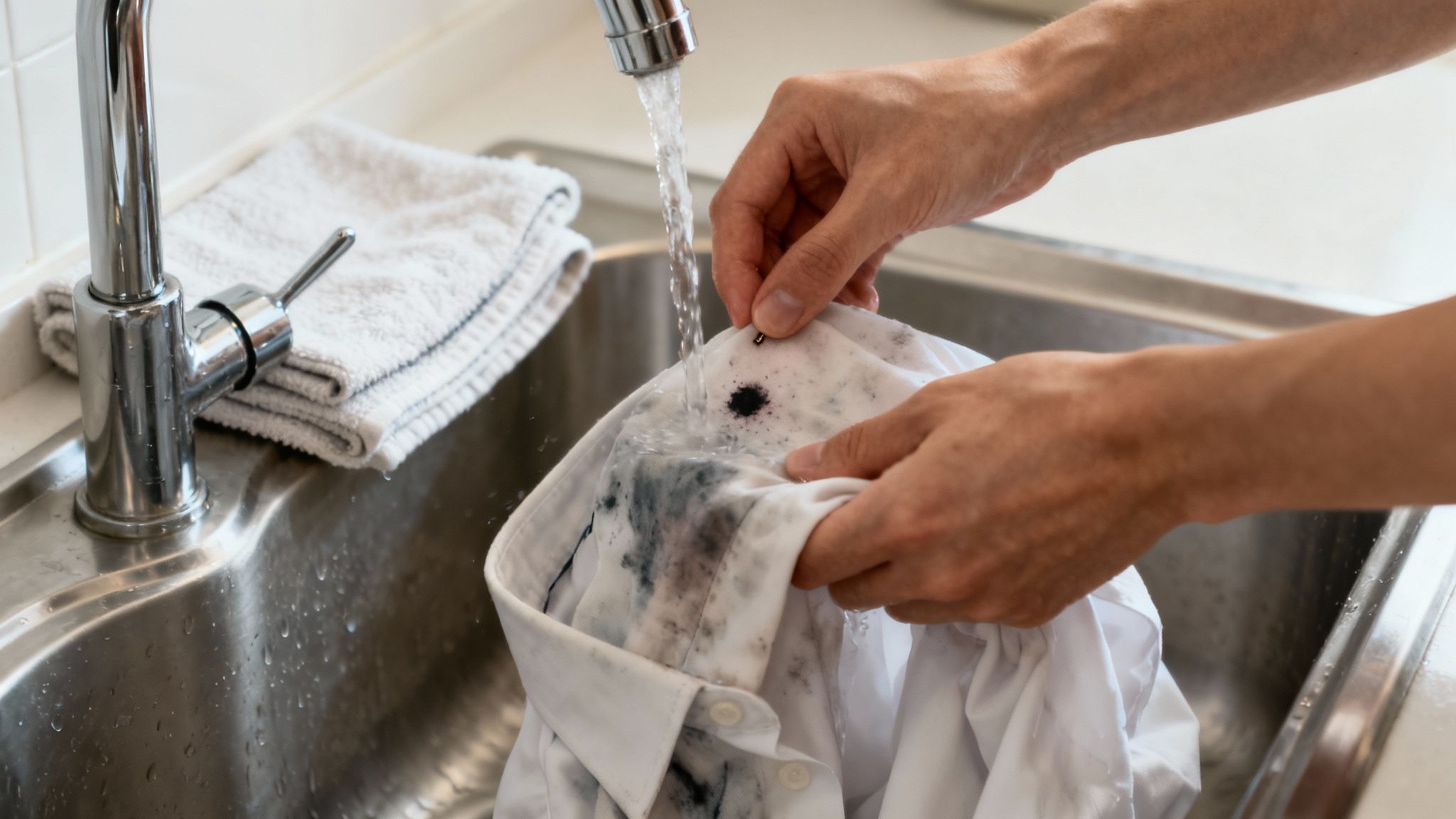
Successfully treating an ink spot is a huge victory, but the battle isn't over just yet. The final wash is where you either lock in your success or accidentally set the stain forever. Honestly, what you do next is probably the most critical part of this whole process.
This finishing touch is what truly saves your clothes.
The most important rule—and it's absolutely non-negotiable—is to never put the garment in a hot dryer unless you are completely certain the stain is gone. The intense heat from a dryer acts like a kiln, permanently bonding any leftover ink particles to the fabric fibers. Once that happens, the stain is there for good.
Choosing the Right Wash Cycle
Okay, so you've pre-treated the ink stain and it looks like it's gone. Now it's time to wash the item, but don't just toss it in with your regular laundry. You need a more strategic approach to rinse away the cleaning solution and any lingering ink.
- Always use cold water. Hot water can reactivate any faint ink remnants and cause them to set. A cold cycle is your safest bet.
- Wash the item by itself. This is a simple step, but it prevents any loosened ink from getting on your other clothes. Trust me, it can save you from a much bigger laundry headache.
If you're dealing with something delicate, like a silk blouse or a nice wool sweater, I'd recommend skipping the machine altogether. Hand-washing in a basin of cool water with a tiny bit of mild detergent gives you total control and is much gentler on the fabric.
Pro Tip: Before you even think about moving the garment to the dryer, give it one last, thorough inspection. Take it somewhere with good light—near a window is perfect. Wet fabric can easily hide faint stains, so look closely at the spot from different angles to make sure every last trace of ink is gone.
The Post-Wash Inspection and What to Do Next
Once the wash cycle is finished, your job still isn't quite done. This final check is your last line of defense against a permanent stain.
If you inspect the garment and see a faint shadow of the ink stain still there, don't panic and definitely don't put it in the dryer. Just repeat the pre-treatment process you used before. stubborn stains often need a second or even third round to fully lift out, and that's completely normal.
Only when you are 100% confident the stain has vanished should you dry the garment. The first time after a treatment, I always suggest air-drying. Laying the item flat or hanging it on a line gives you one last chance to spot any ink you might have missed while it was wet. This careful, patient approach is the real secret to making it look like that ink stain never even happened.
Your Top Ink Stain Questions, Answered
Even when you know the basics, a real-life ink emergency always seems to throw a curveball. What about that mystery stain you just found on a jacket you haven't worn since last year? Or the classic pen explosion when you're miles from home? These are the tricky situations that can leave you stumped.
Think of this as your go-to guide for those "what now?" moments. We'll walk through the most common questions we hear, giving you clear, practical answers so you can handle any ink mishap with confidence.
Can I Get Rid of an Old, Set-In Ink Stain?
This is the big one, and the honest-to-goodness answer is: maybe. A fresh stain is always easier to tackle, but an old one isn't a guaranteed lost cause. It just requires more patience and a bit of a reality check.
An old, dried stain has had plenty of time to really bond with the fabric fibers. A quick dab with alcohol isn't going to cut it here. You’ll need to bring out the heavy hitters.
- Soak it First: Your first move should be to pre-soak the stained area. Let it sit in a solvent like rubbing alcohol for at least 30 to 60 minutes. This is crucial for rehydrating and loosening those stubborn, dried-up ink particles.
- A Little Elbow Grease: After a good soak, grab an old, soft-bristled toothbrush and gently scrub the spot. This helps work the alcohol deeper into the fabric's weave without causing damage.
- Rinse and Repeat: Don't be surprised if you have to repeat the soak-and-scrub cycle two or even three times. You're looking for gradual progress, so don't get discouraged if the stain doesn't vanish on the first attempt.
And a golden rule: only launder the garment after you’ve removed as much of the stain as you can. Always air-dry it afterward to make absolutely sure the stain is gone before applying any heat.
What if I Get Ink on My Clothes When I'm Out?
An ink stain when you're out and about can feel like a total nightmare, but a quick response can save the day. The goal here is immediate damage control until you can get home and treat it properly.
First thing’s first: step away from the water. If it’s a ballpoint pen, the ink is oil-based. Water will just repel the oil and could make the stain spread even further. You need to find something with alcohol in it.
A travel-sized bottle of hand sanitizer is an absolute lifesaver for this exact scenario. The high alcohol content makes it the perfect on-the-go stain fighter. Just squeeze a little bit onto the stain and gently blot with a napkin. This will start breaking down the ink and stop it from setting.
No hand sanitizer? Your next best option is to blot the fresh stain with a dry cloth or paper towel. At the very least, you'll absorb the excess ink and keep it from getting any worse.
Does the Hairspray Trick Actually Work?
Yes... but there's a huge "if" attached. The old-school hairspray trick worked because traditional hairsprays were loaded with alcohol, the very solvent that breaks down ink. The problem is, many modern formulas are now alcohol-free, which renders them totally useless against an ink stain.
So, if you want to give it a shot, you absolutely must check the ingredients list. If alcohol is one of the top ingredients, you're in business. Spray it on the stain, let it sit for a minute, and then blot it away. It’s a decent hack in a pinch, but honestly, pure rubbing alcohol is a much safer and more reliable bet.
Dealing with stubborn stains can be exhausting, and sometimes, the best solution is to let a professional handle it. Columbia Pike Laundry offers expert stain treatment and dry cleaning services to rescue your favorite garments. Instead of spending your weekend battling ink, let us give you your time back. Schedule a pickup today and experience the relief of a perfectly clean wardrobe, delivered right to your door.
Popular Blog Articles

Meet the Author
Daniel Logan didn’t start CPL because he loved laundry. He started it because his family was drowning in time debt, and laundry was one of the biggest weights.
Mornings were chaos with two kids under 5. Evenings felt like catch-up. And weekends? Gone to sorting socks and folding piles.
He knew his story wasn’t unique. So he built a business that gave families like his just a little bit of breathing room one load at a time.
With no laundry experience but deep tech skills, Daniel rolled up his sleeves, doing every job himself while building systems that turned it into a modern laundry service that saves customers time, simplifies their lives, and delivers reliability they can count on.
That’s where CPL began. Not from a playbook, but from pain. From one dad trying to buy back time: for himself, and for every household like his.






